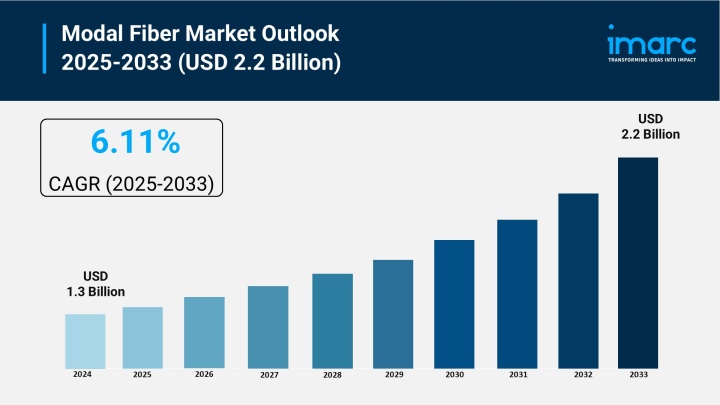

Market Overview:
The Modal Fiber Market is experiencing significant expansion, driven by Growth in Fashion and Apparel Sector, Rising Adoption in Athleisure and Increasing Environmental Consciousness. According to IMARC Group's latest research publication, "Modal Fiber Market: Global Industry Trends, Share, Size, Growth, Opportunity and Forecast 2025-2033", The global modal fiber market size reached USD 1.3 Billion in 2024. Looking forward, IMARC Group expects the market to reach USD 2.2 Billion by 2033, exhibiting a growth rate (CAGR) of 6.11% during 2025-2033.
This detailed analysis primarily encompasses industry size, business trends, market share, key growth factors, and regional forecasts. The report offers a comprehensive overview and integrates research findings, market assessments, and data from different sources. It also includes pivotal market dynamics like drivers and challenges, while also highlighting growth opportunities, financial insights, technological improvements, emerging trends, and innovations. Besides this, the report provides regional market evaluation, along with a competitive landscape analysis.
Grab a sample PDF of this report: https://www.imarcgroup.com/modal-fiber-market/requestsample
Our Report Includes:
Growth Factors in the Modal Fiber Industry:
The significant growth in the fashion and apparel sector along with the increasing utilization of modal fiber in manufacturing sustainable clothing materials is primarily driving the global modal fiber market. Modal fiber is distinguished by its exceptional softness and silk-like lustrousness, making it highly desirable for premium clothing lines. The fiber's high absorbency properties and resistance to shrinkage and fading make it an ideal choice for manufacturers producing durable, long-lasting garments. The growing prominence of modal fiber in the luxury fashion industry on account of its excellent drape quality, high-end texture, and resemblance to luxuriant silk is also propelling the global market.
The rising adoption of modal fiber in athleisure owing to numerous associated benefits, such as improved breathability, quicker drying, thermal and chemical resistance, is catalyzing the market growth. Increasing consumer participation in sports and recreational activities is acting as a significant growth-inducing factor. Modal fiber-based athletic wear provides enhanced comfort during physical activities while maintaining shape and appearance after repeated washing. The fiber's moisture-wicking properties make it particularly suitable for activewear and sportswear applications, meeting the demands of health-conscious consumers who prioritize both performance and comfort.
The increasing environmental consciousness coupled with the improving consumer willingness to spend more on ethical and clean fashion, is creating a positive outlook for the market. Modal fiber, being a semi-synthetic cellulose fiber primarily obtained from beech trees, represents a more sustainable alternative to conventional synthetic fibers. The production process of modal fiber is generally more environmentally friendly, requiring less water and energy compared to traditional textile manufacturing. Consumers are increasingly aware of the environmental impact of their purchasing decisions and are actively seeking products made from renewable and biodegradable materials.
Key Trends in the Modal Fiber Market
The advent of the work-from-home model due the sudden outbreak of the COVID-19 pandemic is fueling the demand for modal fiber-based loungewear that offers enhanced comfort and improved durability. As remote work arrangements continue even post-pandemic, consumers are investing in comfortable yet presentable clothing suitable for home offices and virtual meetings. Modal fiber's soft texture and breathable nature make it ideal for all-day wear, leading to increased adoption in casual and loungewear categories.
The emergence of micro modal fiber, due to its high moisture-wicking, stretchability, and resistance to shrinkage characteristics, is anticipated to fuel the global modal fiber market during the forecast period. Micro modal represents the next generation of modal fibers, featuring even finer filaments that create an ultra-soft fabric with superior draping qualities. This innovation is particularly appealing to manufacturers of high-end intimate apparel, luxury bedding, and premium clothing lines where exceptional softness and comfort are paramount.
The increasing requirement for lightweight and high-performance materials from the automotive and aerospace industries for manufacturing seat covers, door panels, headliners, etc., is further catalyzing the product demand. Modal fiber's combination of strength, durability, and aesthetic appeal makes it suitable for interior applications in transportation. The fiber's resistance to fading and excellent dimensional stability ensure that automotive and aerospace components maintain their appearance and functionality over extended periods.
We explore the factors propelling the Modal Fiber market growth, including technological advancements, consumer behaviors, and regulatory changes.
Modal Fiber Market Report Segmentation:
Breakup by Type:
Long fiber is characterized by its long length and high strength, while short fiber has a lower melting point and different processing characteristics.
Breakup by Application:
Textile represents the largest segment due to modal fiber's exceptional softness, silk-like lustrousness, and suitability for sustainable clothing manufacturing.
Breakup by Region:
Asia Pacific dominates the modal fiber market due to strong textile manufacturing capabilities and growing fashion industry in the region.
Note: If you require specific details, data, or insights that are not currently included in the scope of this report, we are happy to accommodate your request. As part of our customization service, we will gather and provide the additional information you need, tailored to your specific requirements. Please let us know your exact needs, and we will ensure the report is updated accordingly to meet your expectations.
About Us:
IMARC Group is a global management consulting firm that helps the world’s most ambitious changemakers to create a lasting impact. The company provide a comprehensive suite of market entry and expansion services. IMARC offerings include thorough market assessment, feasibility studies, company incorporation assistance, factory setup support, regulatory approvals and licensing navigation, branding, marketing and sales strategies, competitive landscape and benchmarking analyses, pricing and cost research, and procurement research.
Contact Us:
IMARC Group
134 N 4th St. Brooklyn, NY 11249, USA
Email: sales@imarcgroup.com
Tel No:(D) +91 120 433 0800
United States: +1–201971–6302
